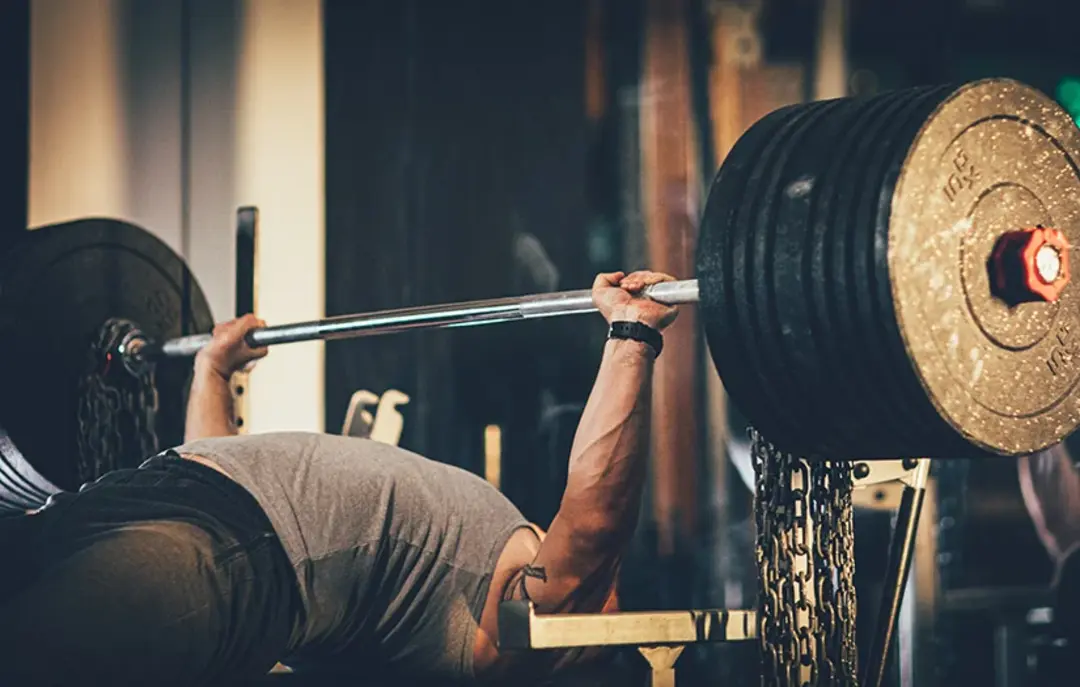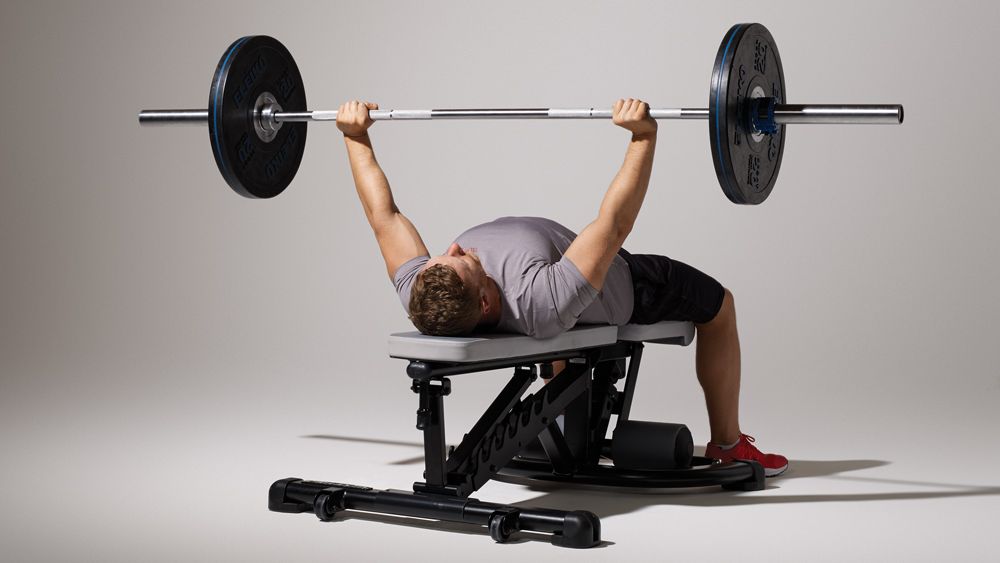What is the Average Bench Press Kg By Age?
.png)
Find out the average bench press kg by age and see how your strength stacks up. Compare age groups and set realistic fitness goals.
When you open one of the Best Fitness Apps and log a bench press, you want more than a number; you want to know how that 70 kg or 100 kg compares to your age, sex, and body weight. This guide breaks down the average bench press in kilograms by age. It provides strength standards, percentiles, one-rep max references, and practical gym benchmarks, allowing you to set realistic targets and plan steady progression.
Is your bench ahead of the curve, average, or does it need a smarter routine to improve? If you want clear, realistic benchmarks for your age group, this guide gives simple numbers and practical next steps.
GetFit AI's AI fitness app turns those benchmarks into action by tracking your lifts, comparing your numbers to age and bodyweight averages, and building easy progress plans that match your goals and training experience.
Summary
- Men tend to peak in the late 20s to mid-30s, with male lifters aged 20 to 29 averaging approximately 100 kg and those aged 30 to 39 averaging about 95 kilograms, and many intermediate one-rep maxes sitting in the mid to high 90s kg.
- Women exhibit a modest decade-to-decade decline, with women aged 20 to 29 averaging approximately 29 kg and women aged 40 to 49 averaging approximately 25 kg, highlighting wide individual variance tied to training history.
- A 140 kg bench is uncommon in competition, with only about 5 percent of male competitors and under 2 percent of female competitors hitting that load at the World Classic & Equipped Bench Press Championships.
- Rigidly copying pro templates often backfires, so use conservative, measurable progression such as increasing training maxes by about 1 to 2.5 percent every 2 to 4 weeks to reduce overreach and injury risk.
- Strength standards depend on bodyweight and training level; for example, a 190-pound man is considered average at 225 pounds and advanced at 315 pounds. Therefore, short-term targets should align with training age and 8- to 16-week mesocycles.
- For older trainees, scale goals to function and recovery: aim for roughly 0.4 to 0.6 times body weight as a safe early milestone, and 0.8 to 1.1 times for long-term trainees. Program 2 to 3 pressing sessions weekly, with about 6 to 12 adequate heavy reps across 6 to 10 week mesocycles.
- This is where GetFit AI's AI fitness app fits in, by converting age and bodyweight benchmarks into adaptive plans that adjust load and session density as users report fatigue or progress.
What is the Average Bench Press Kg By Age For Men?

Men’s bench press strength usually peaks in the late 20s to mid-30s, with a typical one-rep max for many intermediate lifters sitting around the mid to high 90s kilogram range; after that, numbers decline gradually as recovery and joint resilience change. Those averages are a useful benchmark, but they are not prescriptions; they serve as a starting point for individualized targets tailored to bodyweight, injury history, and training age.
How does the average bench press kg change across the decades?
A male lifter in the 20-29 age group typically benches 100 kg, according to Strength Level, which reflects population strength standards and a common one-rep max for intermediate lifters in their physical prime. Men aged 30-39 have an average bench press of 95 kg, indicating a modest decline that often results from shifting life demands, slower recovery, and different training priorities during that decade. By the 40s and beyond, averages drop further as tendon stiffness, cumulative load, and time available for hard training exert an effect; many lifters compensate by prioritizing technique, tempo, and upper-back accessory work.
Why do two men of the same age bench very different weights?
Bodyweight and composition change absolute numbers dramatically, so a 90-kilogram athlete benching 100 kg is not the same performance as a 70-kilogram athlete hitting the same lift. Training history matters too: neural efficiency, skill at the lift, and consistent progressive overload separate steady improvers from those who plateau. Lifestyle factors such as sleep, stress, and joint health introduce variance that the raw bench press average by age does not capture, which is why raw norms are only one piece of the picture.
Most people set goals by copying those headline numbers and a pro’s routine because it feels straightforward and motivating. That familiar approach works at first, but it hides real costs: missed progress, unnecessary injuries, and training that does not align with your recovery capacity as you age. Solutions like GetFit AI personalize athlete-derived templates with adaptive load and volume, conversational coaching to adjust progressions in real-time, and recovery-aware programming, so users can maintain the performance intent of elite routines while scaling safely to their age, body weight, and training history.
How should you turn an average bench press kg by age into a usable goal?
Treat the age-based average as a checkpoint, not a target. Start by converting the average into relative terms, such as a percentage of body weight or a target range for training maximum, then select athlete-style templates that match your recovery and training frequency. Use short testing cycles, conservative progression increments, and scheduled deloads to maintain momentum. If pain or stalled progress appears, retrench on technique and accessory work rather than pushing heavier loads. Think of innovative progression as tuning an engine, not flooring the pedal; you want sustainable power, not occasional redline bursts.
Averages are like a public map of mountain peaks; they tell you where others have stood, not how you must climb.
The detail that changes the story is yet to come, and it will make you question how we set strength goals.
What is the Average Bench Press Kg By Age For Women?

Women’s bench numbers move predictably with age: highest averages occur in the late 20s, then decline gradually through the 40s and beyond, but individual training history creates wide variance. These decade-by-decade averages are helpful signposts, not prescriptions; use them to compare your trajectory, not to box your potential.
What are the decade benchmarks?
For a practical snapshot, consider population averages published by reputable fitness sources. Women aged 20-29 can bench press an average of 29 kg. That figure, published by RitFit Sports in 2021, reflects a recreational population where many lifters are near their physical peak. Similarly, Women aged 40-49 can bench press an average of 25 kg. That number, from the same 2021 dataset, illustrates the modest downward shift commonly seen as recovery windows and life demands change.
Why does strength drift downward in the 40s, and how does it feel in training?
This pattern consistently appears across coached programs and multi-cycle training blocks: persistent trainees in their 40s report smaller week-to-week gains, a more frequent need for extra recovery, and frustration when numbers slip despite their best efforts. That frustration is real, it exhausts motivation, and it often pushes lifters to chase heavy singles rather than rebuild volume and technique. Physiological changes, shifting priorities, and accumulated microtrauma explain the trend; however, the emotional effect is the part that breaks momentum if left unaddressed.
How do athlete-derived routines scale across ages?
Most lifters start by copying a pro routine because it promises straightforward progress, and that familiar approach works for a while. The hidden cost emerges when the program’s intensity and volume remain fixed as recovery capacity changes, resulting in stalled lifts or niggles that accumulate into missed months of training. Platforms like GetFit AI offer an alternative path: they map athlete-style templates to your age, training age, and weekly stressors, then adapt load and session density as you report fatigue or progress, preserving the intent of elite work while lowering the risk of overreach.
If you want to set realistic, age-aware targets, how should you program?
If recovery is plentiful, progressive overload in small, consistent increments will make a significant difference. When sleep, work, or joint sensitivity limit training, prioritize frequency and technique over chasing single-day maxes, and increase load in smaller jumps with longer microcycles. Think of strength like maintaining a classic car: regular, modest investments in tuning and parts keep it running for decades, while sporadic high-rev sessions accelerate breakdown. Use a mix of heavier compound days, deliberate accessory work for pressing mechanics, and planned recovery weeks to lock in gains without burning out.
That common gap between average lifters and extremes raises a question about rarity and context that is more complex than it appears.
Related Reading
- Best Fitness Apps
- How Many Pull Ups Should I Be Able To Do
- Average Bench Press By Age
- Average Grip Strength Male
- Average Bench Press
- How Much Does A Bench Press Bar Weigh
- Average Male Bench Press
- How Much Can The Average Man Bench Press
How Rare is a 140kg Bench?

A 140kg bench press is uncommon and marks someone who has moved beyond casual strength work into disciplined, targeted training. It sits near the upper tail of the distribution for most gym populations and remains selective even among lifters who compete.
How rare is it for 140kg to be at the top at meets?
Look at competition results to see how concentrated that load is. At the World Classic & Equipped Bench Press Championships, only 5% of male competitors lifted 140kg or more, according to the 2025 Results, which show that a 140kg bench is still an achievement within elite fields, not just a baseline.
How often do women reach that number?
It is much rarer among female competitors; in the same 2025 championships, less than 2% of female lifters managed a 140kg bench, according to the World Classic & Equipped Bench Press Championships 2025 results, reflecting how body composition, weight classes, and participation levels shape the threshold.
What does it actually take beyond brute force?
Think in phases, not miracles. Build through accumulation blocks with controlled volume for 6 to 12 weeks, then an intensification block of 4 to 6 weeks that introduces heavy doubles and singles. Finish with a short peaking cycle before testing. Include specific assistance work, like paused benching, close-grip presses, and targeted upper-back rowing, to protect the shoulder and transfer force to the bar. Small, consistent increases to your training max, on the order of 1 to 2.5 percent every 2 to 4 weeks, keep progress measurable and lower the chance of abrupt failure.
Why copying pro programs often stalls progress, and what you can do instead
Most lifters follow celebrity or professional templates because they promise speed and clarity, which makes them feel more comfortable. That familiar approach works for a while, but when recovery, life stress, or injury risk enter the picture, a one-size routine fragments into missed sessions and stalled numbers. Solutions like AI fitness app centralize athlete-derived templates while adapting load, volume, and frequency to an individual’s feedback, reducing overreach and preserving the intent of elite programs while fitting real life.
Ready to train like the legends and finally achieve the body you've always wanted? GetFit AI's AI fitness trainer app lets you follow the exact workout routines that helped Arnold Schwarzenegger, Kobe Bryant, Cristiano Ronaldo, Serena Williams, and over 11 other elite athletes become champions. You can also chat with them whenever you need guidance or motivation. Download the #1-rated AI fitness app for free today to get fit for less than the cost of a single month's gym membership. Because greatness isn't born, it's built one workout at a time.
That threshold is telling, but what it means for a 190-pound man is where the real questions start.
How Much Should a 190 Pound Man Bench?

For a 190-pound man, strength standards depend on training level: an entry point for many gyms sits near a solid, sustainable average, while advanced lifters push substantially higher as they specialize. According to Strength Level, a 190-pound man should be able to bench press 225 pounds to be considered average, and to be considered advanced, a 190-pound man should be able to bench press 315 pounds.
How should you pick a realistic short-term target?
Look at training age and weekly workload first, not just the headline number. If you train 2 to 3 upper-body sessions per week with consistent progressive overload, expect measurable one-rep max gains in 8 to 16 week blocks; pick a testing window at the end of a 6 to 12 week mesocycle and track small, repeatable jumps. Treat the standard as a destination on a map, then break the route into weekly volume and intensity milestones you can actually hit without missing sessions.
What movement choices actually accelerate bench progress?
Prioritize transfer-focused lifts that address weak links and build bar speed under load: heavy floor presses and pin presses to build mid-range stability, incline dumbbell presses for sternocostal strength and balance, and chest-supported rows plus face pulls to shore up the scapular and posterior chain. Utilize concentrated triceps work with progressive overload, and incorporate banded or speed work on lighter days to enhance bar velocity. Think of the plan like tuning a watch; each tiny adjustment tightens the mechanism, allowing heavy lifts to run cleaner.
What measurement approach keeps progress honest?
Replace guesswork with objective markers: track RPE on your heavy sets, log your best reps at fixed percentages, and use small microplates to raise your training max in 1.25- to 2.5-pound increments when volume and technique remain strong. Add a simple weekly volume metric, total tonnage on bench variations, and aim to raise it 5 to 10 percent across a 4 to 8 week accumulation phase. Those numbers indicate whether the program is effective long before a maximum day occurs.
Most lifters copy celebrity or pro templates because they promise clarity and a fast path to bigger numbers, and that approach feels sensible when you just want results. The hidden cost is rigidity, which occurs when fixed volumes and intensities clash with work, sleep, or nagging shoulder stiffness, leading to missed sessions and slow backsliding. Platforms like GetFit AI map athlete-derived templates to your training age and recovery signals, then adapt load, session density, and accessory selection. Hence, you maintain the athlete's intent without compromising fragility.
What common mistakes slow progress the most?
Chasing single heavy attempts without building consistent volume is the fastest way to plateau; so is skipping objective testing and relying on how a session "felt" instead of concrete tonnage and rep-for-rep tracking. Fix both by programming alternating heavy and volume days, logging every set, and insisting on small, measurable increases across weeks rather than dramatic one-shot jumps.
If you want to lift like an athlete, think in terms of systems, not stunts; small, frequent wins add up to permanent strength gains.
That next question about strength at 60 is going to change how you think about longevity and progress.
Related Reading
- Bench Press Standards
- Do Pull Ups Work the Chest
- Symmetric Strength
- Average Deadlift Weight
- Grip Strength Norms
- 1 Rep Max Chart
- Average Male Deadlift
- Good Bench Press Weight
What is a Good Bench Press For a 60-year-old Old Man?

A helpful way to judge a good bench press for a 60-year-old man is by considering function and relative strength, rather than a single headline number. Aim for a press that supports daily tasks and hobbies, while allowing for steady, measurable progress. For most men in this decade, that looks like a conservative, weekly planable program that builds toward pressing somewhere between about half your body weight and slightly above your body weight, depending on your training history and joint health.
How do I turn population averages into a personal target?
Relative targets scale better than raw numbers because body weight, tendon health, and training age influence risk and reward. If you are new to consistent lifting, consider aiming for 0.4 to 0.6 times your body weight as a safe early milestone. If you have decades of consistent training, a reasonable performance zone to pursue is 0.8 to 1.1 times your bodyweight, while maintaining tight frequency and recovery. The point is not chasing a number; it is choosing a load that lets you add volume week to week without flare-ups.
What should I change in technique and exercise selection?
Prioritize joint-friendly positions and ranges, small increases in eccentric control, and variations that reduce peak shoulder torque. Swap some barbell work for neutral-grip dumbbell presses and floor or pin presses to limit end-range stress, and use controlled tempo on the lowering phase to build tendon resilience. This pattern appears consistently in older trainees: when mobility and thoracic extension are restored, pressing strength increases without requiring significant jumps in weight.
Why do so many programs break down for lifters over 60?
Most athletes adopt one-size-fits-all routines because they are clear and motivating, and that works for a while. However, the hidden cost is rigidity: fixed volume and intensity collide with sleep deficits, joint stiffness, and rising life stress, leading to missed sessions and chronic soreness. Platforms like GetFit AI bridge that gap by mapping athlete-derived templates to an individual’s recovery and movement constraints, then adjusting load, session density, and accessory selection so the intent of elite routines stays intact while fragility falls away.
What progression plan keeps you improving without overtraining?
Use frequency and effective reps, not sporadic heavy singles. A practical plan involves two to three pressing sessions per week across 6 to 10 week mesocycles, with one higher-intensity day and one higher-volume day, aiming for roughly 6 to 12 adequate heavy reps per week on main pressing patterns. Track RPE and sleep quality as your primary feedback; when RPE drifts up for the same weight and quality, reduce volume for one week and rebuild from there. Think of progress as tightening a watch spring, not slamming the mainspring harder.
How do benchmarks from broader datasets fit in here?
Benchmarks are signposts, not prescriptions, and they remind us how context matters. According to Strength Level, "A 190-pound man should be able to bench press 225 pounds to be considered average." Those norms are tied to specific body weights and training distributions, so translating them for a 60-year-old requires scaling by recovery and movement quality. Likewise, Healthline reports that men aged 40-49 can bench press an average of 80 kg. Shows how averages shift across decades, which is useful only when you convert them to relative, functional goals.
What signals tell you to pause or change course?
Sharp joint pain, progressive swelling, or a sudden drop in sleep and appetite while training are non-negotiable warning signs. This struggle is familiar: many older trainees report plateauing because they maintain the same volume while their connective tissue tolerance decreases, and this exhaustion erodes motivation. When that happens, switch to low-load high-frequency work, increase mobility sessions, and prioritize posterior chain balance before reintroducing heavy loading.
A short, physical image to remember
Think of the shoulder like a hinge that earns durability through steady, precise oiling, not repeated heavy slams; little, consistent maintenance beats occasional grand gestures.
The frustrating part is this: making elite athlete routines fit a 60-year-old body is not about copying the set lists; it is about translating them to a single person’s recovery and movement story.
Make Your Favorite Athlete Your Fitness Trainer | Try GetFit AI's AI Trainer App for Free Today

Consider GetFit AI when you want athlete-derived programs that actually fit your life, scale with your recovery, and make steady gains feel realistic instead of forced. Most people default to copying pro plans because they are clear, but that rigidity often stalls progress and creates avoidable risk. Platforms like GetFit AI personalize load, timing, and conversational coaching in real-time, which is reflected in outcomes. According to the GetFit AI Website, 90% of users reported improved fitness levels within three months. On the Google Play Store, the app has garnered over 1 million downloads.
Related Reading
- Average Deadlift Weight Kg
- Best Hiit Workout App
- Average Bench Press By Age 16
- Best Free Workout Apps
- Average Deadlift Weight For Male
- Best Workout Apps
- Average Bench Press Kg By Age
- Best Calisthenics Workout App
- Best Workout Tracker App
- Best Gym Workout App



.png)











